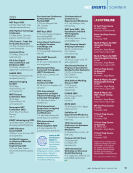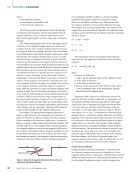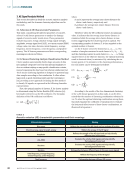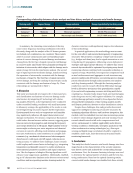In summary, the clustering center analysis of the ring
count–center frequency clustering combination selected in
this study, along with the analysis of the AE feature parame-
ters behind each combination, are consistent. These results
achieve accurate categorization and corresponding expla-
nation of concrete damage levels and damage mechanisms.
Among them, the first type of signal represents mild damage
in concrete under axial tensile stress, primarily involving the
initiation of microcracks, which aligns with the damage mech-
anism of stage D1 from the time history analysis. The second
type of signal represents moderate damage, mainly involving
the expansion of microcracks, consistent with the damage
mechanism of stage D2. The third type of signal represents
severe damage, involving the cracking of macroscopic cracks,
consistent with the damage mechanism of stage D3. These
relationships are summarized in Table 7.
4. Discussion
This study systematically investigates the evolutionary laws
and classification mechanisms of concrete damage under
axial tension by integrating AE technology with cluster-
ing analysis. However, as the experiments were conducted
under controlled loading conditions with small specimens
in laboratory settings, the applicability of the results to real-
world engineering structures requires further exploration.
Environmental factors such as temperature and humidity
may significantly influence AE signal characteristics and
damage mechanisms. For instance, temperature fluctuations
could induce thermal stresses within concrete, triggering spon-
taneous microcrack propagation and altering the frequency
and energy distribution of AE signals. High-humidity environ-
ments might accelerate pore-water migration and chemical
corrosion in concrete, affecting crack initiation and propaga-
tion rates. Furthermore, noise interference in complex envi-
ronments (e.g., mechanical vibrations and electromagnetic
disturbances) could mask valid AE signals, reducing moni-
toring accuracy. To address these challenges, future research
could employ multi-sensor fusion technology (e.g., integrating
temperature and humidity sensors) to enable synchronous
environmental parameter acquisition and signal compensa-
tion. The development of adaptive filtering algorithms could
enhance noise suppression capabilities. Additionally, establish-
ing an AE characteristic database under diverse environmental
conditions and incorporating machine learning models for
dynamic correction could significantly improve the robustness
of this methodology.
In practical applications, this methodology must account
for the scale effects and material heterogeneity of engineering
structures. The geometric complexity of large-scale structures
(e.g., bridges and dams) may lead to signal attenuation or scat-
tering during AE propagation, influencing sensor deployment
strategies and signal capture efficiency. To address this, sensor
network layouts should be optimized by adopting array-based
monitoring schemes combined with waveguide technology to
expand coverage. Meanwhile, heterogeneous components such
as steel reinforcements and aggregates in real structures may
generate multimodal AE features, necessitating precise damage
pattern identification through multi-parameter joint analysis
and deep learning models. Although the clustering analysis
results from current research effectively differentiate damage
levels in laboratory specimens, their generalization capabil-
ity in real-world engineering scenarios involving multi-factor
coupling (e.g., dynamic loads, fatigue loads, and material aging
under long-term service) still requires validation. For example,
evolving damage pathways caused by time-dependent factors
demand further integration of time-varying analysis models
and lifespan prediction theories to refine classification criteria.
Despite these challenges, this study provides theoretical
support for intelligent monitoring of concrete structures. By
optimizing algorithm efficiency and hardware integration, this
method could be embedded into real-time monitoring systems
to achieve online damage diagnosis and early warning. Future
research should extend to full-scale components and real
service environments to validate applicability under diverse
working conditions. Additionally, synergistic application with
other nondestructive testing technologies (e.g., fiber-optic
sensing and digital image correlation) should be explored to
establish a multi-scale, multi-dimensional structural health
monitoring framework.
5. Conclusions
This study first divided concrete axial tensile damage into three
stages based on the characteristics of the acoustic emission
time history curves and analyzed the corresponding damage
mechanisms. Next, the k-means clustering technique was used
to determine the optimal number of clusters and the best clus-
tering combination. Based on the optimal clustering results,
concrete axial tensile damage was classified into three severity
ME
|
AXIALTENSION
TA B L E 7
Corresponding relationship between cluster analysis and time history analysis of concrete axial tensile damage
Clustering results Degree of damage Damage mechanism Damage stages defined by time history curves
Category 1 Mild Microcrack initiation D1 (0–20% stress level)
Category 2 Moderate Microcrack expansion D2 (20–75% stress level)
Category 3 Severe Macroscopic crack formation D3 (75–100% stress level)
50
M AT E R I A L S E V A L U AT I O N • M AY 2 0 2 5
count–center frequency clustering combination selected in
this study, along with the analysis of the AE feature parame-
ters behind each combination, are consistent. These results
achieve accurate categorization and corresponding expla-
nation of concrete damage levels and damage mechanisms.
Among them, the first type of signal represents mild damage
in concrete under axial tensile stress, primarily involving the
initiation of microcracks, which aligns with the damage mech-
anism of stage D1 from the time history analysis. The second
type of signal represents moderate damage, mainly involving
the expansion of microcracks, consistent with the damage
mechanism of stage D2. The third type of signal represents
severe damage, involving the cracking of macroscopic cracks,
consistent with the damage mechanism of stage D3. These
relationships are summarized in Table 7.
4. Discussion
This study systematically investigates the evolutionary laws
and classification mechanisms of concrete damage under
axial tension by integrating AE technology with cluster-
ing analysis. However, as the experiments were conducted
under controlled loading conditions with small specimens
in laboratory settings, the applicability of the results to real-
world engineering structures requires further exploration.
Environmental factors such as temperature and humidity
may significantly influence AE signal characteristics and
damage mechanisms. For instance, temperature fluctuations
could induce thermal stresses within concrete, triggering spon-
taneous microcrack propagation and altering the frequency
and energy distribution of AE signals. High-humidity environ-
ments might accelerate pore-water migration and chemical
corrosion in concrete, affecting crack initiation and propaga-
tion rates. Furthermore, noise interference in complex envi-
ronments (e.g., mechanical vibrations and electromagnetic
disturbances) could mask valid AE signals, reducing moni-
toring accuracy. To address these challenges, future research
could employ multi-sensor fusion technology (e.g., integrating
temperature and humidity sensors) to enable synchronous
environmental parameter acquisition and signal compensa-
tion. The development of adaptive filtering algorithms could
enhance noise suppression capabilities. Additionally, establish-
ing an AE characteristic database under diverse environmental
conditions and incorporating machine learning models for
dynamic correction could significantly improve the robustness
of this methodology.
In practical applications, this methodology must account
for the scale effects and material heterogeneity of engineering
structures. The geometric complexity of large-scale structures
(e.g., bridges and dams) may lead to signal attenuation or scat-
tering during AE propagation, influencing sensor deployment
strategies and signal capture efficiency. To address this, sensor
network layouts should be optimized by adopting array-based
monitoring schemes combined with waveguide technology to
expand coverage. Meanwhile, heterogeneous components such
as steel reinforcements and aggregates in real structures may
generate multimodal AE features, necessitating precise damage
pattern identification through multi-parameter joint analysis
and deep learning models. Although the clustering analysis
results from current research effectively differentiate damage
levels in laboratory specimens, their generalization capabil-
ity in real-world engineering scenarios involving multi-factor
coupling (e.g., dynamic loads, fatigue loads, and material aging
under long-term service) still requires validation. For example,
evolving damage pathways caused by time-dependent factors
demand further integration of time-varying analysis models
and lifespan prediction theories to refine classification criteria.
Despite these challenges, this study provides theoretical
support for intelligent monitoring of concrete structures. By
optimizing algorithm efficiency and hardware integration, this
method could be embedded into real-time monitoring systems
to achieve online damage diagnosis and early warning. Future
research should extend to full-scale components and real
service environments to validate applicability under diverse
working conditions. Additionally, synergistic application with
other nondestructive testing technologies (e.g., fiber-optic
sensing and digital image correlation) should be explored to
establish a multi-scale, multi-dimensional structural health
monitoring framework.
5. Conclusions
This study first divided concrete axial tensile damage into three
stages based on the characteristics of the acoustic emission
time history curves and analyzed the corresponding damage
mechanisms. Next, the k-means clustering technique was used
to determine the optimal number of clusters and the best clus-
tering combination. Based on the optimal clustering results,
concrete axial tensile damage was classified into three severity
ME
|
AXIALTENSION
TA B L E 7
Corresponding relationship between cluster analysis and time history analysis of concrete axial tensile damage
Clustering results Degree of damage Damage mechanism Damage stages defined by time history curves
Category 1 Mild Microcrack initiation D1 (0–20% stress level)
Category 2 Moderate Microcrack expansion D2 (20–75% stress level)
Category 3 Severe Macroscopic crack formation D3 (75–100% stress level)
50
M AT E R I A L S E V A L U AT I O N • M AY 2 0 2 5













































































